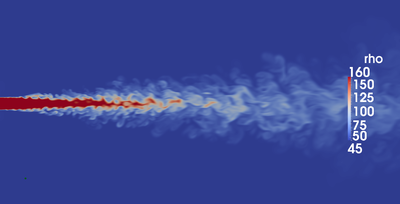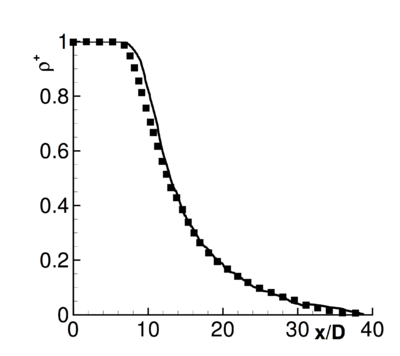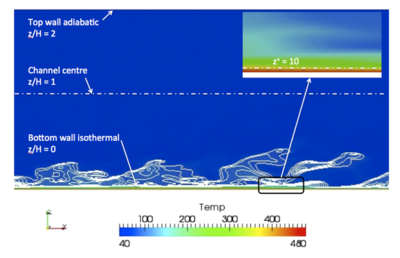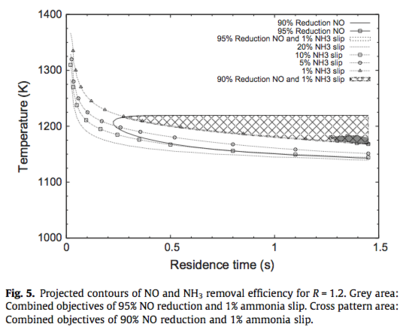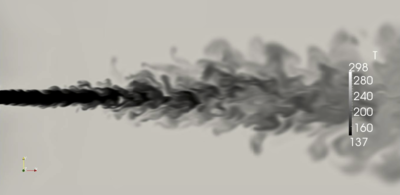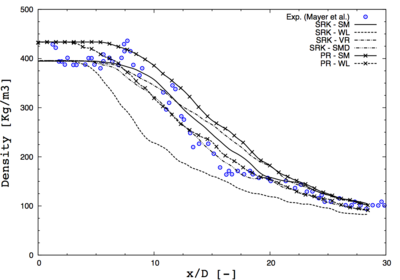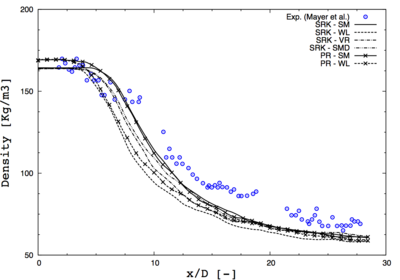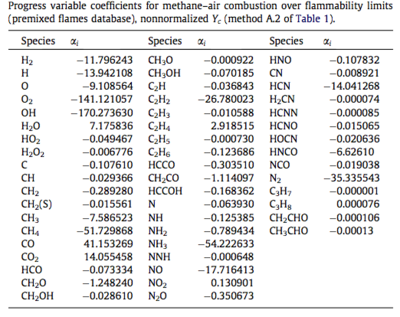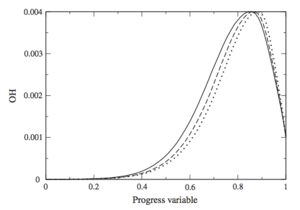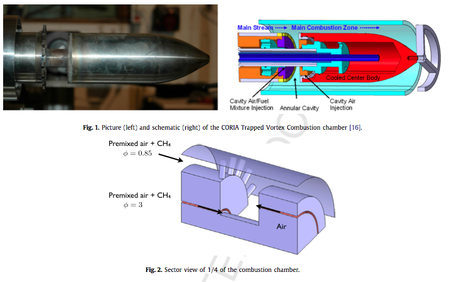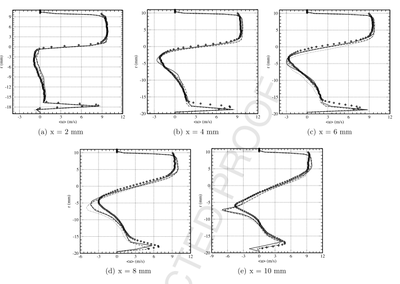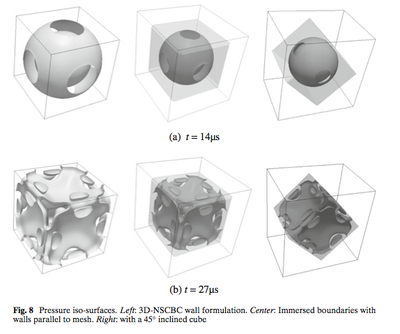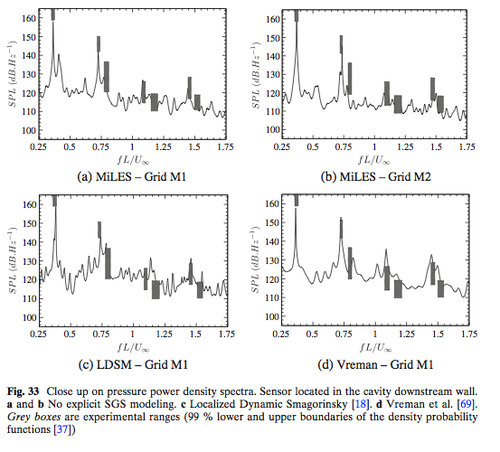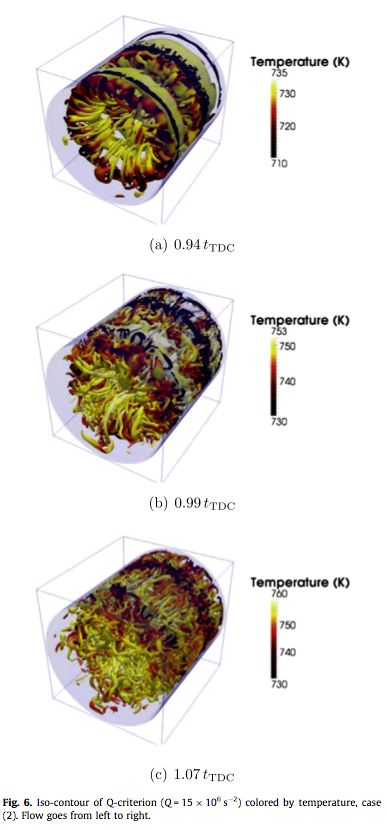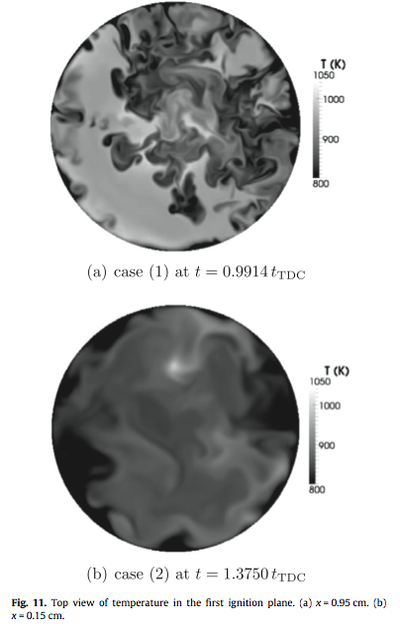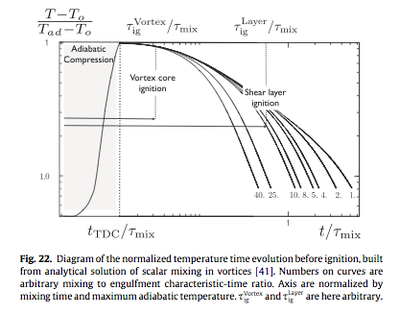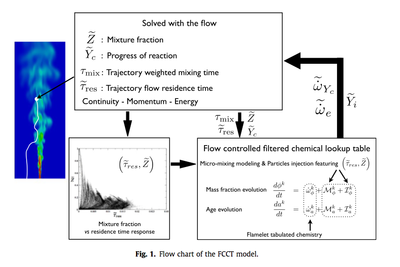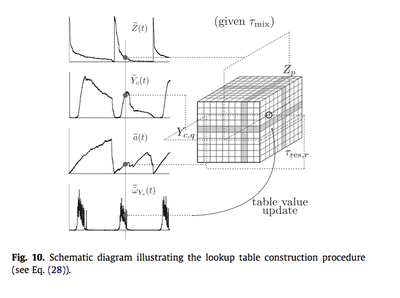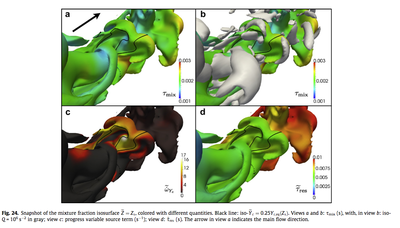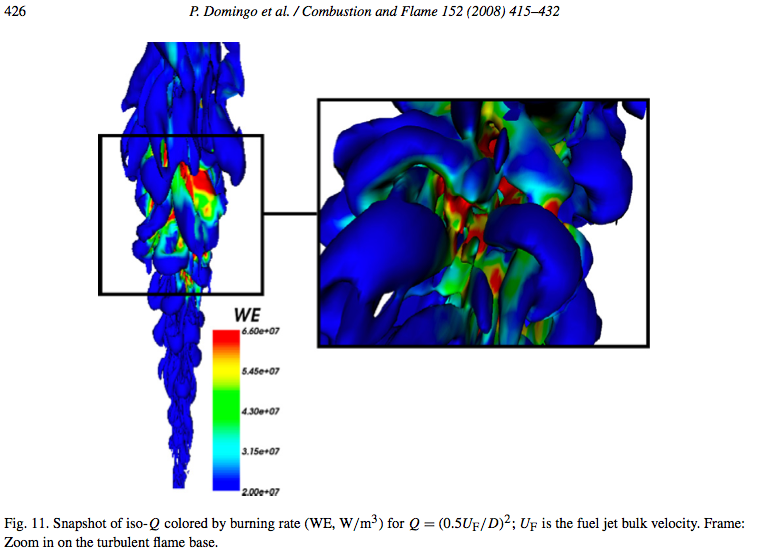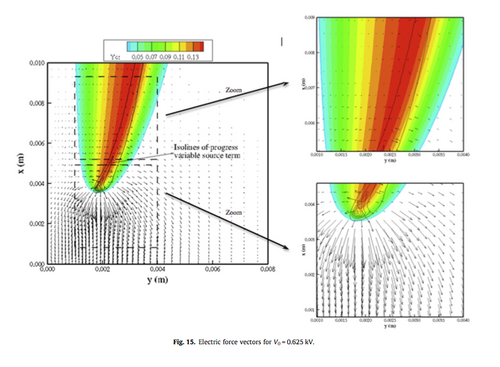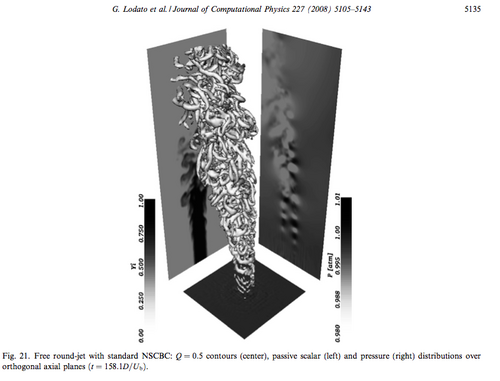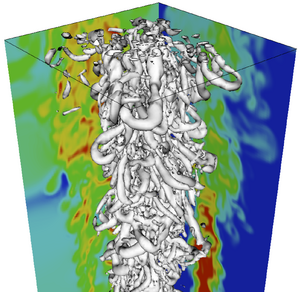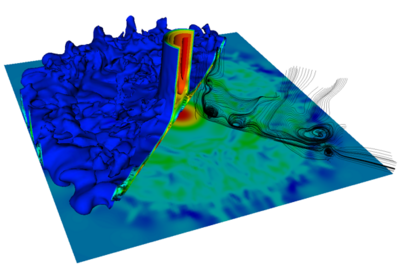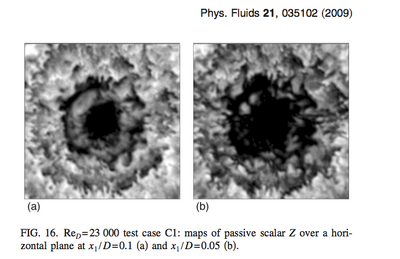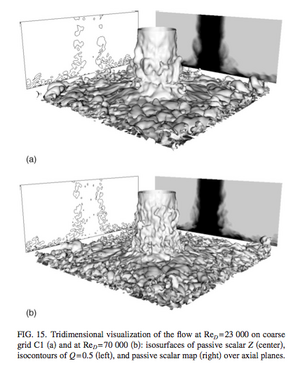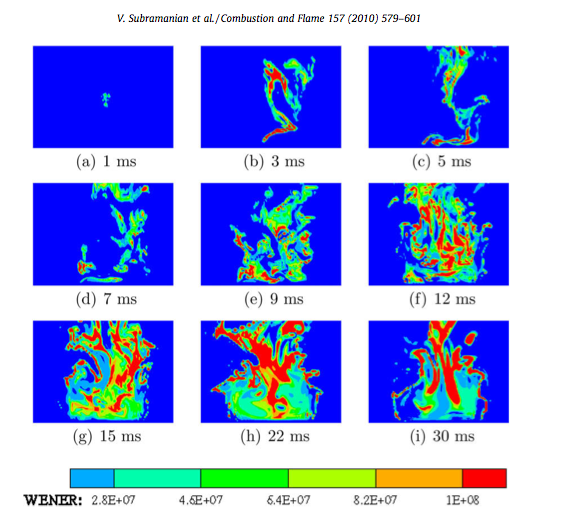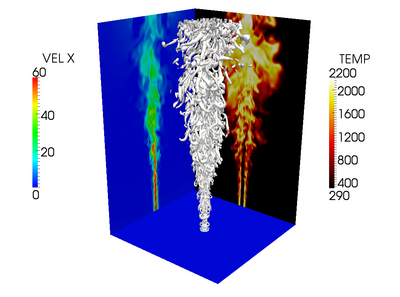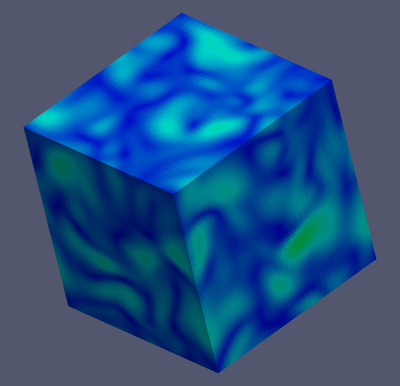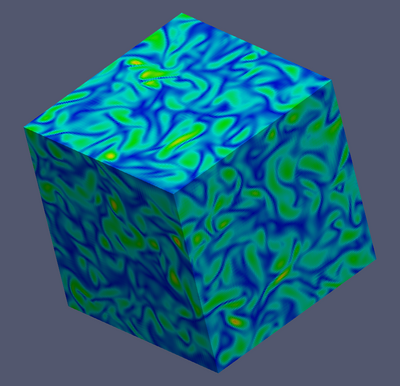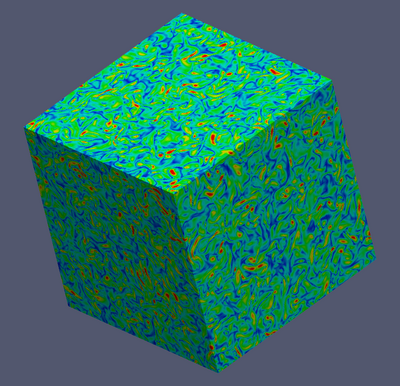Difference between revisions of "SiTCom-B Gallery"
| Line 6: | Line 6: | ||
|- | |- | ||
| [[File:Rho.png|center|400px]] | | [[File:Rho.png|center|400px]] | ||
| − | |||
|- | |- | ||
| Mayer's jet with the tabulated approach. | | Mayer's jet with the tabulated approach. | ||
| + | |- | ||
| + | | [[File:Rho2.png|center|400px]] | ||
| + | |- | ||
| Comparison with the multi-species formulation (symbols). | | Comparison with the multi-species formulation (symbols). | ||
|} | |} | ||
Revision as of 12:29, 17 February 2016
Contents
- 1 Framework for real-gas compressible reacting flows with tabulated thermochemistry
- 2 LES of a supercritical channel flow using a shock capturing numerical scheme
- 3 Chemistry downsizing for simulating selective non catalytic reduction DeNOx process
- 4 LES of supercritical fluid injection
- 5 An optimization-based approach to detailed chemistry tabulation
- 6 LES of a Trapped Vortex Combustor
- 7 Immersed boundaries in LES of compressible flows
- 8 DNS of a Rapid Compression Machine
- 9 Mixing time-history effects: Flow-Controlled Chemistry Tabulation
- 10 Flame base stabilization in vitiated partially-premixed mixture
- 11 Electric field and edge-flame
- 12 NSCBC vs 3D-NSCBC in jets
- 13 Impinging round jets
- 14 Ignition of a bluff-body burner
- 15 Jet flame-surface & Scalar SGS variance in LES
- 16 Nonpremixed jet flame
- 17 DNS of a non-reacting HIT
Framework for real-gas compressible reacting flows with tabulated thermochemistry
Combustion in liquid rocket engines happens under severe thermodynamical conditions: pressure exceeds the critical pressure of injected propellants and temperature is cryogenic. Such a situation requires an important effort of modeling: real gas effects are incorporated through cubic equations of state along with pressure-correction terms, and transport properties follow specific rules. Modeling for turbulent combustion is also an issue and is presently considered with tabulated chemistry thus reducing the number of transported variables. In this study, a framework is provided to deal with real-gas compressible reacting flows with tabulated thermochemistry. As a consequence, a cubic equation of state for tabulated thermochemistry is derived with the adopted thermodynamic relations, and the temperature computation is adapted to incorporate real gas effects through the tabulated thermochemistry approach. Two-dimensional reactive and non-reactive theoretical test cases have been performed with success to demonstrate the capacity of the new method. Finally, the simulation of a three-dimensional non-reactive single injector derived from Mayer’s experiment, that consists of a supercritical nitrogen jet injection into a warm nitrogen atmosphere, is also performed with success. The comparison between the tabulated approach and a fully coupled reference solution leads to similar results for the density values along the jet axis and for the spreading rate.
| Mayer's jet with the tabulated approach. |
| Comparison with the multi-species formulation (symbols). |
- X. Petit, G. Ribert, P. Domingo (2015) Framework for real-gas compressible reacting flows with tabulated thermochemistry, J. Supercritical Fluids, 101: 1-16. link
LES of a supercritical channel flow using a shock capturing numerical scheme
This paper investigates the simulation of supercritical fluids flowing inside small cooling channels. In the context of liquid rocket engines, a strong heat flux coming from the combustion chamber (locally 80 MW/m2 for the Ariane 5 main-engine) may lead to very steep density gradients close to the wall. These gradients have to be thermodynamically and numerically captured to really understand the mechanism of heat transfer from the wall to the fluid. A shock-capturing WENO numerical scheme, usually used with the ideal gas law, was extended to real gases and applied to the simulation of an academic channel flow configuration that uses hydrogen as fluid. Results showed very elongated ligaments in the streamwise direction with a deep penetration in the wall-normal direction. A linear analysis was performed to link the fluctuations of compressibility factor (Z’) to temperature fluctuations (T’) in the case of an adiabatic and isothermal wall. The usual Strong Reynolds Analogy (SRA) could not be confirmed with real gas effects. Z fluctuations was found lower than 1%, thus becoming harder to distinguish the physical fluctuations from the numerical error and a more refine simulation should be require to deliver a definitive conclusion.
| Channel flow configuration. |
- G. Ribert, D. Taieb, V. Yang (2015) Large-eddy simulation of a supercritical channel flow using a shock capturing numerical scheme, Computers & Fluids, 117: 103-113. link
Chemistry downsizing for simulating selective non catalytic reduction DeNOx process
The introduction of strongly non-linear chemistry effects in numerical simulation of flows in Selective Non Catalytic Reduction (SNCR) DeNOx is addressed. In these systems of large dimensions, NOx in flue gas is reduced by injecting either ammonia or urea as a reducing agent. First, an analysis is performed to seek out with detailed chemistry (207 elementary reactions, 33 species by Klippenstein et al. (2011) ) the importance of global parameters in the performance of NO removal, such as temperature and major species concentration levels. Then, this detailed reaction mechanism needs to be simplified for its subsequent introduction in flow simulations. In this paper, two different methods relying on auto- mated optimization tools for reducing the cost of chemistry are discussed. The first one is based on the tabulation of the detailed chemical response from canonical problems, using automatically defined progress variables. In the second one, a large sample set of detailed chemistry solution points is processed by an iterative optimization procedure, leading to a reduced two-step chemistry reproducing the response of the global parameters characterizing NO removal.
| Optimal conditions for NO removal from NH3 | Novel reduced kinetics for Large-Eddy Simulation of DeNOx |
- B. Farcy, A. Abou-Taouk, L. Vervisch, P. Domingo, N. Perret (2014) Two approaches of chemistry downsizing for simulating Selective Non Catalytic Reduction DeNOx Process, Fuel, 118: 291-299.
LES of supercritical fluid injection
Mixing is a key point for thrust and efficiency of combustion systems. It becomes crucial in the case Liquid Rocket Engines as large investments are involved. Besides, the pressure in liquid rocket combustion cham- ber often exceeding the critical point of loaded propellants, mixing becomes an important scientific issue as fluid properties differ from classical ideal gas assumption. In this study, two configurations are studied to evaluate the impact of subgrid models on mixing. Firstly, Mayer’s experiments of trans- and super- critical nitrogen jet injection into a warm nitrogen atmosphere have been numerically investigated with a structured numerical code called SiTCom-B. SiTCom-B solves Direct Numerical Simulations and Large Eddy Simulations equations for perfect or real gas equation of states. In this study, Soave–Redlich–Kwong (SRK) and Peng–Robinson (PR) equation of state are used with appropriated thermodynamics relations and validated against NIST data. Three-dimensional LES are conducted for two cases (cases 3 and 4 in Mayer et al.’s paper [HMT 39: 709-719 (2003)]) with real-gas NSCBC treatment. Several sub-grid scale models (constant (SM) and dynamic (SMD) Smagorinsky, WALE (WL) and Vreman (VR)) are tested and the results are compared to experimental data for density on jet axis: a very good agreement is obtained on a light mesh (11.6 million of points) with the SRK equation of state and standard Smagorinsky model. Flow structures are evidenced with Schlieren snapshots. Secondly, the Mascotte test-bench from ONERA is simulated with SiTCom-B based on Soave–Redlich–Kwong equation of state and Smagorinsky models. The simulated non-reacting case is characterized by a very short liquid oxygen dense core because of the strong density and velocity gradients boosting mixing efficiency.
| LES of Mayer's jet. | |
| Case 3 (T=126.9 K, p=3.97 MPa). | Case 4 (T=137.0 K, p=3.98 MPa). |
- X. Petit, G. Ribert, G. Lartigue, P. Domingo (2013) Large-eddy simulation of supercritical fluid injection, J. Supercritical Fluids, 84: 61-73. link
An optimization-based approach to detailed chemistry tabulation
Finding a progress variable so that all relevant species can be retrieved from its knowledge, is not always straightforward; specifically for fuel mixtures composed of more than a single hydrocarbon, or for simpler fuels but under conditions where the global reaction progress is not continuous, for instance in the case of cool-flame ignition. To overcome these difficulties, automated methods are discussed to define progress variables in which all species of a chemical scheme, even minor ones, are involved. This is done formulating constraints applied to progress variables definition: they should evolve in a monotonic manner from fresh to burnt gases and species derivative in progress variable-space should stay moderate for tabulation accuracy. This set of constraints is discretized along chemical trajectories observed in laminar canonical flames, to be formulated in terms of an ensemble of inequalities, which are solved using optimization tools. The outcome is a set of weighting coefficients to be applied to every species of the detailed chemical scheme, in order to construct the progress variable-space. The methods have been successfully applied to methane and kerosene premixed flamelets and to n-heptane self-ignition, under conditions with cool-flame effects.
| Coefficients of the optimized progress variable for CH4/Air combustion | Progress variable is expressed from all species mass fraction | OH tabulation valid at all equivalence ratios |
- N. Yi-Shuai, L. Vervisch, P.-D. Tao (2013) An optimization-based approach to detailed chemistry tabulation: Automated progress variable definition, Combust. Flame, 160(4): 776-785.
LES of a Trapped Vortex Combustor
Flow and flame dynamics inside a trapped vortex combustor are analyzed from Large Eddy Simulation (LES) results compared against measurements. The Navier-Stokes equations are solved in their fully compressible form over a cartesian grid resorting to immersed boundaries to account for the complex geometry, composed of an annular flow impacting a set of axisymmetric rods (flame holders) before interacting with a cavity. Various cases are considered, varying the main flow rate, the length of the cavity, injecting secondary-air and also adding a swirling motion. From these cases, three main cavity flow regimes emerge. The modeling of molecular diffusion in LES with presumed probability density function (pdf), as filter of premixed flamelets, is also discussed. It is shown that a dynamic correction to molecular diffusion may be computed from the pdf control parameters to ensure the correct laminar flame speed, whatever the mesh used. Finally, the study of the turbulent flame evolution within the cavity in the various cases, suggests that swirling motion is mandatory to favor the global burner stability.
| Geometry of the Trapped Vortex Combustion chamber | Q-critrion - Visualisation of the turbulent flow topology |
| Comparison against experiments |
- C. Merlin, P. Domingo, L. Vervisch (2012) Large Eddy Simulation of turbulent flames in a Trapped Vortex Combustor (TVC) - A flamelet presumed-pdf closure preserving laminar flame speed, Comptes Rendus Mecanique, 340 (11/12), pp. 917-932.
Immersed boundaries in LES of compressible flows
Methods to immerse walls in a structured mesh are examined in the context of fully compressible solutions of the Navier Stokes equations. The ghost cell approach is tested along with compressible conservative immersed boundaries in canonical flow configurations; the reflexion of pressure waves on walls arbitrarily inclined on a cartesian mesh is studied, and mass conservation issues examined in both a channel flow inclined at various angles and flow past a cylinder. Then, results from Large Eddy Simulation of a flow past a rectangular cylinder and a transonic cavity flow are compared against experiments, using either a multi-block mesh conforming to the wall or immersed boundaries. Different strategies to account for unresolved transport by velocity fluctuations in LES are also compared. It is found that immersed boundaries allow for reproducing most of the coupling between flow instabilities and pressure-signal properties observed in the transonic cavity flow. To conclude, the complex geometry of a trapped vortex combustor, including a cavity, is simulated and results compared against experiments.
| Pressure wave reflection on inclined walls | Transonic cavity flow simulation |
| Comparison of pressure spectra against measurements |
- C. Merlin, P. Domingo, L. Vervisch (2013) Immersed Boundaries in Large Eddy Simulation of Compressible Flows, Flow Turbulence and Combustion, 90(1), pp. 29-68.
DNS of a Rapid Compression Machine
Turbulence and combustion inside a compression machine, experimentally studied by Guibert et al. [Flow Turbulence and Combust. 84(1):~79-85, 2010], are simulated to get some insight on flow-physics and ignition scenarios of a reactive-gas mixture pushed by a piston through a turbulence-grid, to be compressed in a fifty-five cubic-centimeter volume. Large Eddy Simulation (LES) with a structured-mesh solver and immersed boundaries are first performed for an inert mixture undergoing the compression, to validate the simulation procedure against experimental results. Then, keeping the flow admission-sequence the same, but downsizing its geometry, a Direct Numerical Simulation (DNS) analysis of the compression/ignition sequence is reported. Simulation parameters are varied for ignition to occur in mixtures featuring various temperature stratification patterns, due to wall cooling and turbulence characteristics. As previously discussed in the literature, conditions favoring spotty- or homogeneous-ignition are evidenced. Depending on characteristic times (coherent structure residence time, flow engulfment and mixing times) ignition may occur within localized compression zones, between vortical structures leading to spotty-ignition, or more homogeneously within large scale flow structures. Very small differences in local temperature and flow topology appear to lead to different routes toward successful auto-ignition. The underlying mechanisms are analyzed from an internal energy budget expressed as a temperature balance equation, to delineate between the contribution of the global adiabatic compression and localized flow divergence induced by turbulence velocity fluctuations. After primary ignition, the propagation phase of ignition is strongly influenced by the acoustic field and the specific temperature scalar dissipation-rate patterns. It is also shown that three-dimensional vortex stretching plays a crucial role, hence two and three-dimensional DNS lead to different ignition scenarios under similar chemical and turbulence intensity conditions.
| Flow injection sequence - Resolution of | Ignition patterns |
| Regime Diagram |
- G. Lodier, C. Merlin, P. Domingo, L. Vervisch, F. Ravet (2012) Self-ignition scenarios after rapid compression of a turbulent mixture weakly-stratified in temperature, Combust. Flame 159(11): 3358-3371.
Mixing time-history effects: Flow-Controlled Chemistry Tabulation
The time history of mixing is known to play a crucial and non-trivial role in non-premixed turbulent combustion. In a first part, Eulerian balance equations are derived for both a flow residence time and a characteristic time of the mixing which the particles gathered in a fluid element have been subjected to in their flow histories. These equations are analyzed and solved in a Large Eddy Simulation (LES) context for a fuel jet mixing with an oxidizer coflow. Typical responses of filtered mixture fraction versus flow residence time are highlighted. In a second part, a Flow-Controlled Chemistry Tabulation (FCCT) is devised in which the effects of unresolved fluctuations of thermochemical variables in LES are simulated, combining partially-stirred reactors with tabulated chemistry. The reactor evolutions are organized to mimick flow engulfment and micro-mixing, so as to reproduce the observed filtered mixture fraction versus residence time response. This allows for dynamically building sub-grid scale joint probability density functions, and thereby the sub-filter response of the non-premixed flames, according to four control parameters: the filtered mixture fraction, the progress of reaction, the flow residence time and a mixing time. Finally, LES of the Cabra et al. [Combust. Flame 143 (2005) 491--506] fuel-jet lifted-flame developing in a vitiated oxidizer environment is performed and results are compared against measurements.
| FCCT procedure | Dynamic construction of advanced chemistry tabulation |
| Turbulent flame response to micro-mixing history |
- N. Enjalbert, P. Domingo, L. Vervisch (2012) Mixing time-history effects in Large Eddy Simulation of non-premixed turbulent flames: Flow-Controlled Chemistry Tabulation, Combust. Flame 159(1): 336-352.
Flame base stabilization in vitiated partially-premixed mixture
The impact of burned gases on flame stabilization is analyzed under the conditions of a laboratory jet flame in vitiated coflow (Cabra~et al. 2005). In this experiment, mass flow rate, temperature, and the exact chemical composition of hot products mixed with air sent toward the turbulent flame base are fully determined. Auto-ignition and partially premixed flame propagation are investigated for these operating conditions from simulations of prototype combustion problems using fully detailed chemistry. Using available instantaneous species and temperature measurements, a priori tests are then performed to estimate the prediction capabilities of chemistry tabulations built from these archetypal reacting flows. The links between auto-ignition and premixed flamelet tables are discussed, along with their controlling parameters. Using these results, Large-Eddy Simulation of the turbulent diluted jet flame is performed, a new closure for the scalar dissipation rate of reactive species is discussed, and numerical predictions are successfully compared with experiments.
- P. Domingo, L. Vervisch, D. Veynante (2008) Large-Eddy Simulation of a lifted methane jet flame in a vitiated coflow Combust. Flame 152(3): 415-432.
Electric field and edge-flame
The role of electric fields in stabilising combustion is a well-known phenomenon. Among the possible mechanisms favouring the anchorage of the flame base, the ion-driven wind acting directly on flow momentum ahead of the flame base could be the leading one. Direct numerical simulation has been used to verify this hypothesis and lead to a better understanding of diffusion flame base anchoring in the pres- ence of an externally applied voltage. In this context, a simplified modelling approach is proposed to describe combustion in the presence of electric body forces. The model reproduces the tendencies of experimental observations found in the literature. The sensitivity of the flame lift-off height to the applied voltage is studied and the modification of the velocity field ahead of the flame base induced by the electric volume forces is highlighted.
- M. Belhi, P. Domingo, P. Vervisch (2010) Direct numerical simulation of the effect of an electric field on flame stability Combust. Flame 157 2286–2297.
- M. Belhi, P. Domingo, P. Vervisch (2013) Modeling of the Effect of DC and AC Electric Fields on the Stability of a Lifted Diffusion Methane/Air Flame, Combustion Theory and Modelling}, http://dx.doi.org/10.1080/13647830.2013.802415
NSCBC vs 3D-NSCBC in jets
Navier-Stokes Characteristic Boundary Conditions (NSCBC) usually assume the flow to be normal to the boundary plane. In this paper, NSCBC is extended to account for convection and pressure gradients in boundary planes, resulting in a 3D-NSCBC approach. The introduction of these additional transverse terms requires a specific treatment for the computational domain's edges and corners, as well as a suited set of compatibility conditions for boundaries joining regions associated to different flow properties, as inlet, outlet or wall. A systematic strategy for dealing with edges and corners is derived and compatibility conditions for inlet/outlet and wall/outlet boundaries are proposed. Direct Numerical Simulation (DNS) tests are carried out on simplified flow configurations at first. 3D-NSCBC brings a drastic reduction of flow distortion and numerical reflection, even in regions of strong transverse convection; the accuracy and convergence rate toward target values of flow quantities is also improved. Then, 3D-NSCBC is used for Large-Eddy Simulation (LES) of a free jet and an impinging round-jet. Edge and corner boundary treatment, combining multidirectional characteristics and compatibility conditions, yields stable and accurate solutions even with mixed boundaries characterized by bad posedness issues (e.g. inlet/outlet). LES confirms the effectiveness of the proposed boundary treatment in reproducing mean flow velocity and turbulent fluctuations up to the computational domain limits.
- G. Lodato, P. Domingo, L. Vervisch (2008) Three-dimensional boundary conditions for Direct and Large-Eddy Simulation of compressible flows J. of Comp. Phys. 227(10): 5105-5143.
Impinging round jets
Wall-jet interaction is studied with Large Eddy Simulation (LES) in which a mixed similarity Sub-Grid Scale (SGS) closure is combined with the Wall-Adapting Local Eddy-viscosity (WALE) model for the eddy-viscosity term. A macrotemperature and macropressure are introduced to deduce a weakly compressible form of the mixed similarity model and the relevant formulation for the energy equation is deduced accordingly. LES prediction capabilities are assessed by comparing flow statistical properties against experiment of an unconfined impinging round-jet at Reynolds number of 23,000 and 70,000. To quantify the benefit of the proposed WALE Similarity Mixed (WSM) model, the lower Reynolds number simulations are also performed using the standard WALE and Lagrangian Dynamic Smagorinsky approaches. The unsteady compressible Navier-Stokes equations are integrated over 2.9 M, 3.5 M and 5.5 M nodes cartesian grids with an explicit fourth-order finite volume solver. Non-reflecting boundary conditions are enforced using a methodology accounting for the three-dimensional character of the turbulent flow at boundaries. A correct wall scaling is achieved from the combination of similarity and WALE approaches; for this wall-jet interaction, the SGS closure terms can be computed in the near-wall region without the necessity of resorting to additional specific treatments. The possible impact of turbulent energy backscatter in such flow configurations is also addressed. It is found that, for the present configuration, the correct reproduction of reverse energy transfer plays a key role in the estimation of near-wall statistics, especially when the viscous sub-layer is not properly resolved.
- G. Lodato, L. Vervisch, P. Domingo (2009) A compressible wall-adapting similarity mixed model for large-eddy simulation of the impinging round jet Phys. Fluids 21:035102.
Ignition of a bluff-body burner
The optimization of the ignition process is a crucial issue in the design of many combustion systems. Large-Eddy Simulation (LES) of a conical shaped bluff body turbulent non-premixed burner has been performed to study the impact of spark location on ignition success. This burner was experimentally investigated by Ahmed et al. (2007). The present work focuses on the case without swirl for which detailed measurements are available. First, cold flow measurements of velocities and mixture fraction are compared with their LES counterparts, to assess the prediction capabilities of simulations in terms of flow and turbulent mixing. Time history of velocities and mixture fraction are recorded at selected spots, to probe the resolved probability density function (pdf) of flow variables, in an attempt to reproduce, from the knowledge of LES resolved instantaneous flow conditions, the experimentally observed reasons of success or failure of spark ignition. A flammability map is also constructed from the resolved mixture fraction pdf and compared with its experimental counterpart. LES of forced ignition is then performed using flamelet fully detailed tabulated chemistry combined with presumed pdfs. Various scenarios of flame kernel development are analyzed and correlated with typical flow conditions observed in this burner. The correlations between, velocities and mixture fraction values at the sparking time, and, the success or failure of ignition, are then further discussed and analysed.
- V. Subramanian, P. Domingo, L. Vervisch (2010) Large-Eddy Simulation of forced ignition of an annular bluff-body burner Combust. Flame 157(3): 579-601.
Jet flame-surface & Scalar SGS variance in LES
- Turbulence motions are, by nature, three-dimensional while planar imaging techniques, widely used in turbulent combustion, give only access to two-dimensional information. For example, to extract flame surface densities, a key ingredient of some turbulent combustion models, from planar images implicitly assumes an instantaneously two-dimensional flow, neglecting the unresolved flame front wrinkling. The objective here is to estimate flame surface densities in statistically two-dimensional flows, modelling unknown flame front wrinkling from known quantities. An excellent agreement is achieved against direct numerical simulation (DNS) data where all three-dimensional quantities are known, but validations in other conditions (larger DNS, experiments) are required.
- Large-Eddy Simulation (LES) provides space-filtered quantities to compare with measurements, which usually have been obtained using a different filtering operation; hence, numerical and experimental results can be examined side-by-side in a statistical sense only. Instantaneous, space-filtered and statistically time-averaged signals feature different characteristic length scales, which can be combined in dimensionless ratios. From two canonical manufactured turbulent solutions, a turbulent flame and a passive scalar turbulent mixing layer, the critical values of these ratios under which measured and computed variances (resolved plus subgrid scale) can be compared without resorting to additional residual terms are first determined. It is shown that actual Direct Numerical Simulation can hardly accommodate a sufficiently large range of length scales to perform statistical studies of LES filtered reactive scalar-fields energy budget based on sub-grid scale variances; an estimation of the minimum Reynolds number allowing for such DNS studies is given. From these developments, a reliability mesh criterion emerges for scalar LES and scaling for scalar sub-grid scale energy is discussed.
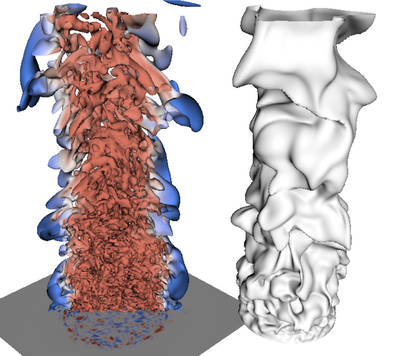
|
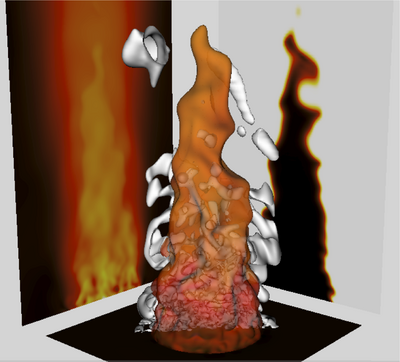
|
| Premixed jet flame | Bunsen flame |
- L. Vervisch, P. Domingo, G. Lodato, D. Veynante (2010) Scalar energy fluctuations in Large-Eddy Simulation of turbulent flames: Statistical budgets and mesh quality criterion Combust. Flame 157(4): 778-789.
- D. Veynante, G. Lodato, P. Domingo, L. Vervisch, E. R. Hawkes (2010) Estimation of three-dimensional flame surface densities from planar images in turbulent premixed combustion Exp. in Fluids 49:267-278.
Nonpremixed jet flame
Detailed chemistry tabulations are mostly based on reaction progress variables used to track species evolutions along trajectories in composition space, which in some cases are obtained from simulations of prototype combustion problems. For hydrocarbon chemistry, these progress variables are usually built from major species, as CO, CO2, H2O to which reactants are sometimes added. Prediction of NO mass fraction is first evaluated by comparing results from single progress variable and flamelet based chemical look-up tables against simulations of reference flames performed with the detailed chemistry mechanism that was used to generate the tabulations. Nitric oxides mainly formed in the burnt gases still evolve once major species have almost reached their equilibrium levels, then large errors in the predictions of NO mass fractions are unavoidable when using a progress variable based on major species only. It is concluded that the time scale separation inherent to NOx species must be included in the progress variable definition. A novel definition of progress variable is proposed for flame based tabulation and tested, which allows for reproducing both major species as well as NO, NO2 and N2O. Large-Eddy Simulation (LES) of a jet flame in a vitiated coflow is performed with the new tabulation and results are compared against experiments.
- G. Godel, P. Domingo, L. Vervisch (2009) Tabulation of NOx chemistry for Large-Eddy Simulation of non-premixed turbulent flames Proc. Combust. Inst. 32: 1555-1551.
DNS of a non-reacting HIT
This is a very simple DNS computation of a HIT with a constant-properties gas.
The main parameters of the simulation are:
- temporal integration: RK3,
- spatial scheme: 4th order skew symmetric
- no AV.
In this series of computations, the number of cell is increased from 64^3 to 256^3.
